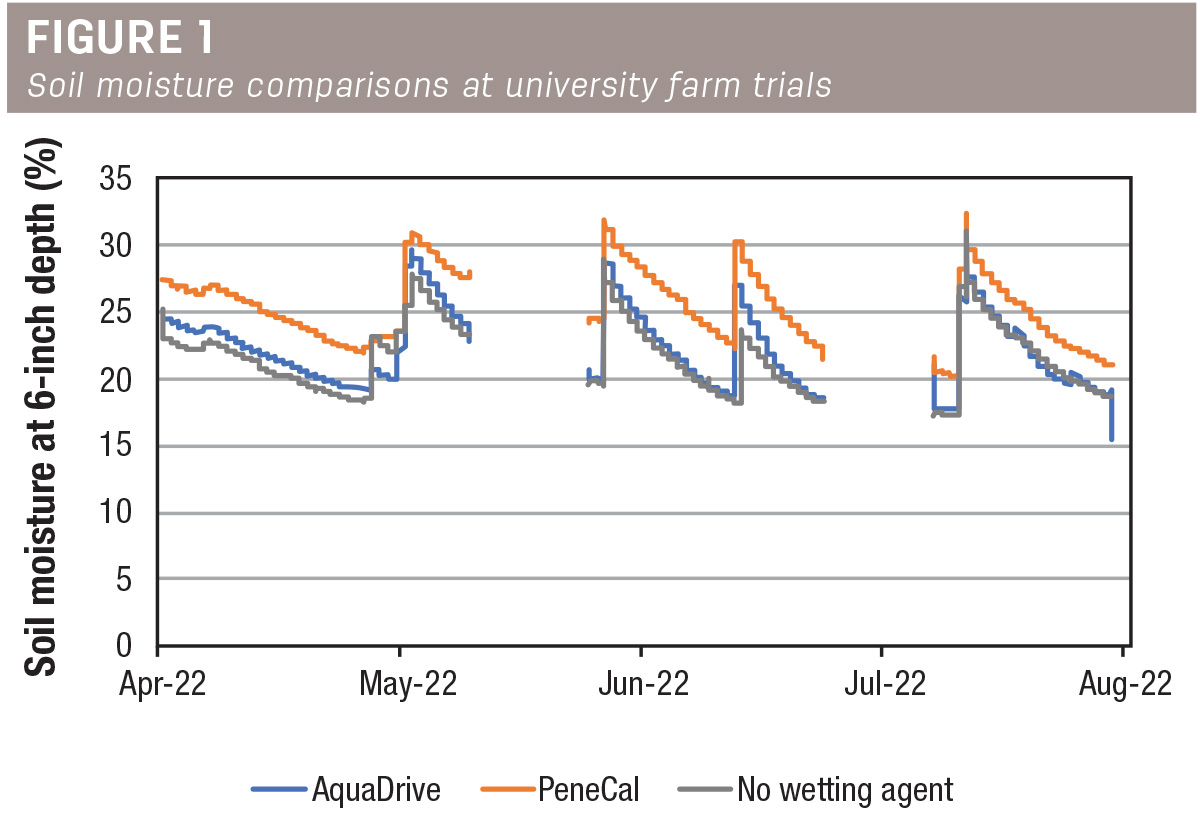Should growers be treating their fields more like golf courses? Interesting question but one that may not be too far-fetched. Golf courses receive a lot of traffic (imagine that) and often have sandy soils that can be hydrophobic or repel water due to high surface tension. This combination often results in poor water infiltration and less-than-ideal turf. A common solution to this problem in golf courses is the application of products known as soil wetting agents that reduce the surface tension of soil. Many of these products are being used or considered for field crops to help improve water infiltration and possibly provide more resiliency to drought.
What are soil wetting agents?
Soil wetting agents (aka, soil surfactants, soil infiltration agents, etc.) are designed to lower the surface tension of soil particles, which can increase water infiltration and water content, thereby causing the soil to be wetter and retain moisture for a longer time. High-repellency soils tend to see much more advantages to wetting agents. In one study, water infiltration increased by 31% (and water content by 40%) on a highly repellent sandy soil, whereas a low-repellency soil had no benefits from a wetting agent.
What is known about their performance?
There is a long list of soil wetting products available on the market. Many of these have been tested and heavily used in the turfgrass industry with documented success, especially on soils with high water repellency. Relatively few studies have been conducted in field crops. To help fill the gap in available data, researchers at Utah State University (USU) evaluated how three common soil wetting agents (AquaDrive, PeneCal and APSA80) affected yield, crop quality and soil moisture levels in silage corn, alfalfa and small-grain forage production. Their research was conducted at three university farms and eight commercial crop fields during 2019-23. The 11 trials had soils with various textures ranging from sandy loam to clay. The wetting agents were sprayed once at the highest rate specified on each label at the beginning of each season.
Do wetting agents increase soil moisture?
To answer this question, USU installed soil sensors in several plots with and without two wetting agents (AquaDrive and PeneCal) at the three university farm trials in Logan, Cedar City and Vernal, Utah. This resulted in a total of eight comparisons in alfalfa and corn. Soil moisture in the top foot of soil was sometimes greater with one or both wetting agents. An example of this in alfalfa in 2022 at the Logan site is in Figure 1. However, across the eight datasets, wetting agents did not consistently have greater moisture and differences were rarely statistically different. Therefore, wetting agents can increase moisture but not consistently across locations and years.

Can they provide drought resiliency?
Wetting agents were applied to alfalfa with full and half irrigation over three years (2021-23) in three university trials. The three wetting agents were not tested at each site or year and there was a total of five tests of each product. Two of the wetting agents increased alfalfa yield by 15% to 25% in one-third of the alfalfa cuttings with full irrigation. Benefits were less frequent with half irrigation – wetting agents only increased yield by 12% in one-fifth of the cuttings with water stress in the half irrigation. Forage quality results were similar to yield and also showed that the benefits of wetting agents were not more frequent in the half irrigation plots than full irrigation. Alfalfa relative feed value (RFV) was increased by all three products in 36% or less of the cuttings with full irrigation and 18% or less of cuttings with half irrigation (Table 1).

Do they improve yield and forage quality?
The use of wetting agents did not impact silage corn yield in six on-farm trials or small-grain forage yield in two on-farm trials. Forage quality of corn silage was sometimes improved with the wetting agents, but silage is often not priced or sold based on quality, so the increase would likely not increase profits. Results for corn silage and small-grain forages in the three irrigation trials were similar to the on-farm trials with no or infrequent differences in yield or forage quality.
Takeaways
The results discussed in this article were from studies conducted on soils that would not be classified as highly hydrophobic with extreme water infiltration issues. Fortunately, these problematic soils are not common on most farms in the Intermountain West. A few key takeaways to consider from these recent USU studies include:
- Wetting agents did not consistently improve soil moisture or crop yield under water stress conditions and thus may not be an effective tool for water conservation or drought resiliency.
- Wetting agents are likely not a cost-effective product for general use on any soil to increase yield or crop quality.
- Wetting agents can and should be evaluated by growers and crop advisers first on hydrophobic soils with poor infiltration where the greatest benefits could be achieved.






